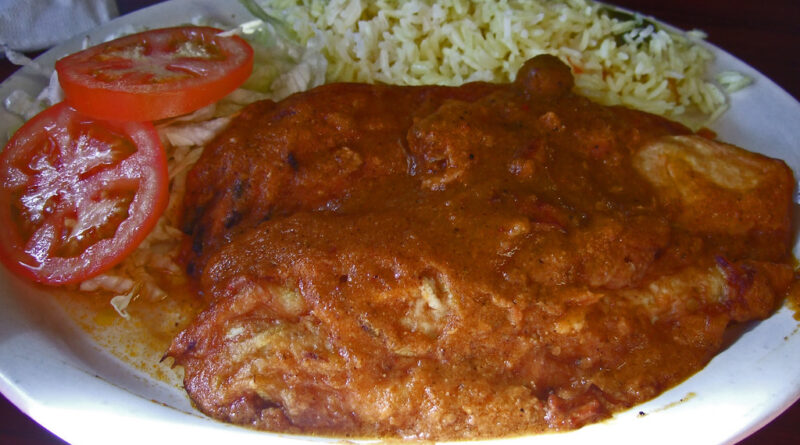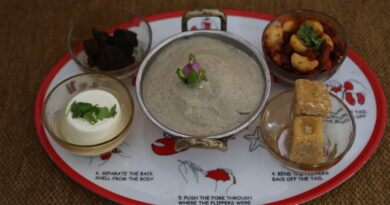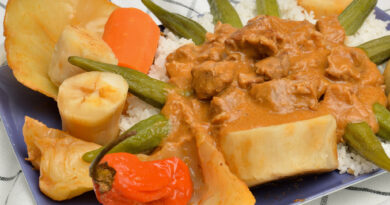Moambe chicken
Exploring the Rich Flavors of Moambe Chicken: A Culinary Journey Through Central Africa
Introduction: In the heart of Central Africa lies a culinary treasure that has captured the hearts and palates of many – Moambe Chicken. This traditional dish, celebrated for its rich flavors and cultural significance, offers a tantalizing glimpse into the diverse culinary landscape of the region. In this article, we embark on a journey to discover the origins, ingredients, preparation methods, and cultural significance of Moambe Chicken.
Origins and History: Moambe Chicken, also known as Poulet Nyembwe or Palm Nut Soup, traces its origins to the vibrant cultures of Central Africa, particularly in countries like the Democratic Republic of Congo (DRC), Republic of Congo (ROC), and Angola. This iconic dish has been a staple in the region for centuries, with its roots deeply intertwined with local traditions and customs.
The name “Moambe” is derived from the Lingala language spoken in parts of Central Africa, where it refers to the process of cooking meats or vegetables in a rich sauce made from palm nuts. Historically, Moambe Chicken was a dish reserved for special occasions and celebrations, symbolizing hospitality, abundance, and communal feasting.
Ingredients: The key ingredient in Moambe Chicken is the rich and creamy sauce made from palm nuts, which lends the dish its distinctive flavor and texture. Palm nuts, harvested from the African oil palm tree, are processed to extract the creamy pulp, which forms the base of the sauce.
In addition to palm nuts, Moambe Chicken typically includes a variety of other ingredients such as chicken, onions, garlic, tomatoes, and a blend of aromatic spices. These ingredients come together to create a harmonious fusion of flavors, with each element contributing to the dish’s unique taste profile.
Preparation Method: The preparation of Moambe Chicken is a labor-intensive process that requires patience, skill, and attention to detail. To begin, the palm nuts are boiled and then pounded to extract the creamy pulp, which is strained to remove any remaining fibers or impurities.
Next, the chicken is marinated in a mixture of spices, onions, and garlic, allowing the flavors to infuse and develop. The marinated chicken is then browned in a hot skillet to seal in the juices and enhance the depth of flavor.
Once the chicken is browned, it is transferred to a pot along with the strained palm nut pulp, tomatoes, and additional seasonings. The mixture is simmered gently over low heat, allowing the flavors to meld together and the sauce to thicken to a rich, velvety consistency.
Cultural Significance: Moambe Chicken holds significant cultural importance in Central African communities, where it is often enjoyed as a symbol of hospitality, unity, and celebration. It is a dish that brings families and friends together around the dining table, fostering a sense of connection and shared heritage.
In addition to its cultural significance, Moambe Chicken also holds nutritional value, providing a rich source of protein, vitamins, and minerals. The palm nut sauce is high in healthy fats and antioxidants, while the chicken provides essential nutrients such as iron, zinc, and B vitamins.
Variations and Regional Differences: While the basic recipe for Moambe Chicken remains the same across Central Africa, there are variations and regional differences that reflect the diverse culinary traditions of the region. In some areas, Moambe Chicken may be prepared with additional ingredients such as okra, eggplant, or plantains, adding depth and complexity to the dish.
In the Democratic Republic of Congo, for example, Moambe Chicken is often served with cassava or rice, while in Angola, it may be accompanied by fungi, a traditional cornmeal porridge. These regional variations highlight the versatility of Moambe Chicken and the creativity of Central African cooks.
Conclusion: In conclusion, Moambe Chicken is more than just a dish – it is a celebration of Central Africa’s rich culinary heritage and cultural diversity. From its humble origins to its cherished place on dining tables across the region, Moambe Chicken embodies the spirit of tradition, community, and shared identity.
Whether enjoyed as a simple family meal or as part of a festive feast, Moambe Chicken continues to captivate the senses and bring people together through its irresistible flavors and timeless appeal. So the next time you find yourself craving a taste of Central Africa, be sure to seek out this culinary masterpiece and experience the magic of Moambe Chicken for yourself.



